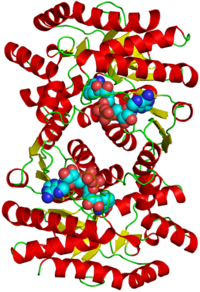
Photo from wikipedia
Mobile Ω-loops play essential roles in the function of many enzymes. Here we investigated the importance of a residue lying outside of the mobile Ω-loop element in the catalytic function… Click to show full abstract
Mobile Ω-loops play essential roles in the function of many enzymes. Here we investigated the importance of a residue lying outside of the mobile Ω-loop element in the catalytic function of an H477R variant of cytosolic phosphoenolpyruvate carboxykinase using crystallographic, kinetic, and computational analysis. The crystallographic data suggest that the efficient transition of the Ω-loop to the closed conformation requires stabilization of the N-terminus of the loop through contacts between R461 and E588. In contrast, the C-terminal end of the Ω-loop undergoes changing interactions with the enzyme body through contacts between H477 at the C-terminus of the loop and E591 located on the enzyme body. Potential of mean force calculations demonstrated that altering the anchoring of the C-terminus of the Ω-loop via the H477R substitution results in the destabilization of the closed state of the Ω-loop by 3.4 kcal mol-1. The kinetic parameters for the enzyme were altered in an asymmetric fashion with the predominant effect being observed in the direction of oxaloacetate synthesis. This is exemplified by a reduction in kcat for the H477R mutant by an order of magnitude in the direction of OAA synthesis, while in the direction of PEP synthesis, it decreased by a factor of only 2. The data are consistent with a mechanism for loop conformational exchange between open and closed states in which a balance between fixed anchoring of the N-terminus of the Ω-loop and a flexible, unattached C-terminus drives the transition between a disordered (open) state and an ordered (closed) state.
Journal Title: Biochemistry
Year Published: 2017
Link to full text (if available)
Share on Social Media: Sign Up to like & get
recommendations!